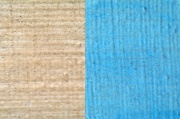Rosin
Description
The solid, resinous residue left after the distillation of Turpentine (oil) from Balsam. The balsam exudate or Gum thus, is usually from the Longleaf pine (Pinus palustris), Cuban pine (Pinus caribaea), Loblolly pine (Pinus taeda), cluster pine (P. pinaster), or Scotch pine (P. sylvestris). Rosin, also called colophony, is a brittle, clear resin with a color ranging from yellow or reddish-brown. It becomes sticky when warm and has a faint pine-like odor. Primarily composed of Abietic acid (about 80%), rosin reacts in hot alkaline solutions to form rosin soaps. Rosin weathers poorly, becoming oxidized and brittle with age. It also has poor moisture resistance. Although many of its aging properties are undesirable, rosin was used as an ingredient in Paint, Varnish, Ink, Adhesive, Sealing wax, soldering Flux, and Linoleum. Because it increases sliding friction, it is commonly used for coating bows of some stringed instruments, and as a slip preventative on the floors of stages and shoes of dancers. The inexpensive resin is also used for sizing Paper.
Synonyms and Related Terms
colophony; colofonia (Esp.); colophane (Fr.); colofonia (It); Greek pitch; wood rosin; sound glue; balsam; gum thus; pine resin; yellow resin; abietic anhydride; violin rosin; colophonium; gum rosin "
Risks
- Dust may cause irritation to skin, eyes and nasal passages.
- Oxidizes easily and may blacken with age.
- Combustible, burning with a yelow, sooty flame.
- Evolves irritating and suffocating fumes on heating.
- ThermoFisher: SDS
Physical and Chemical Properties
- Soluble in ethanol, acetone, turpentine, acetic acid, carbon disulfide. Insoluble in water.
- Saponification number = 150-200;
- Acid number =150-180.
| CAS | 8050-09-7 |
|---|---|
| Melting Point | 100-150 C |
| Density | 1.07-1.10 g/ml |
| Refractive Index | 1.525-1.548 |
Comparisons
Resources and Citations
- R. J. Gettens, G.L. Stout, Painting Materials, A Short Encyclopaedia, Dover Publications, New York, 1966 Comment: melting point = 100-130C; acid value = 165-175
- Encyclopedia Britannica, http://www.britannica.com Comment: Rosin. Retrieved July 1, 2003.
- Thomas B. Brill, Light Its Interaction with Art and Antiquities, Plenum Press, New York City, 1980 Comment: ref. index = 1.525; old CAS # 1065-31-2
- Ralph Mayer, A Dictionary of Art Terms and Techniques, Harper and Row Publishers, New York, 1969 (also 1945 printing)
- Matt Roberts, Don Etherington, Bookbinding and the Conservation of Books: a Dictionary of Descriptive Terminology, U.S. Government Printing Office, Washington DC, 1982
- Dictionary of Building Preservation, Ward Bucher, ed., John Wiley & Sons, Inc., New York City, 1996
- The Dictionary of Paper, American Paper Institute, New York, Fourth Edition, 1980
- M. Doerner, The Materials of the Artist, Harcourt, Brace & Co., 1934
- Boise Cascade Paper Group, The Paper Handbook, Boise Cascade, Portland OR, 1989
- Michael McCann, Artist Beware, Watson-Guptill Publications, New York City, 1979
- Pam Hatchfield, Pollutants in the Museum Environment, Archetype Press, London, 2002
- G.S.Brady, Materials Handbook, McGraw-Hill Book Co., New York, 1971 Comment: p. 671
- Richard S. Lewis, Hawley's Condensed Chemical Dictionary, Van Nostrand Reinhold, New York, 10th ed., 1993
- Paintings Specialty Group, Painting Conservation Catalog, Wendy Samet (ed.), AIC, Washington, DC, 1998
- The Merck Index, Martha Windholz (ed.), Merck Research Labs, Rahway NJ, 10th edition, 1983 Comment: entry 8424; ref. index=1.525
- Theodore J. Reinhart, 'Glossary of Terms', Engineered Plastics, ASM International, 1988
- Art and Architecture Thesaurus Online, http://www.getty.edu/research/tools/vocabulary/aat/, J. Paul Getty Trust, Los Angeles, 2000
- CRC Handbook of Chemistry and Physics, Robert Weast (ed.), CRC Press, Boca Raton, Florida, v. 61, 1980 Comment: ref. index=1.548

